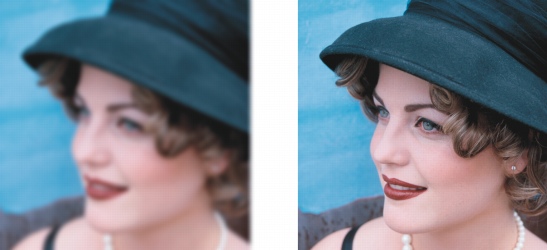Quick links to procedures on this page:
Sharpening images
You can sharpen images to increase contrast, enhance image edges, or reduce shading. To sharpen an image, or an editable area of an image, you can use filters or brushstrokes. Filters can also be applied using a lens. For more information about lenses, see “Working with lenses.” Sharpening is usually done after adjusting the color and tone of an image and after resampling or resizing.

You can reveal more image detail by sharpening an image.
To sharpen an image by applying a filter |
|
2.
|
|
Move the Percentage slider to set the amount of sharpening that is applied each time you click a thumbnail button.
|
|
•
|
Unsharp mask — lets you accentuate edge detail and focus blurred areas in the image without removing low-frequency areas.
|
|
•
|
Adaptive unsharp — lets you accentuate edge detail by analyzing the values of neighboring pixels. This filter preserves most image detail, but its effect is most apparent in high-resolution images.
|
|
•
|
Sharpen — lets you accentuate the edges of the image by focusing blurred areas and increasing the contrast between neighboring pixels. Move the Background slider to set the threshold for the effect. Lower values increase the number of pixels changed by the sharpening effect.
|
![]()
|
•
|
|
The Unsharp mask filter provides best results for most photographs.
|
|
•
|
|
Most sharpen filters support all color modes except 48-bit RGB, 16-bit grayscale, paletted, and black-and-white. The Sharpen filter supports all color modes except paletted and black-and-white.
|
![]()
|
•
|
|
You can access each of the sharpen filters individually by clicking Effects
|
|
•
|
|
You can use this procedure to sharpen an editable area of an image.
|
To sharpen selected areas by applying brushstrokes |
![]()
|
•
|
|
You can quickly choose a square or round brush shape by clicking the Round nib button
|